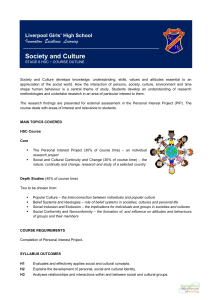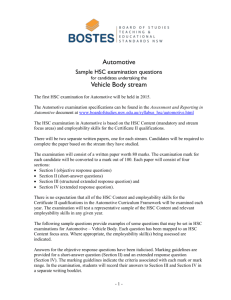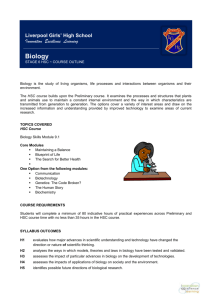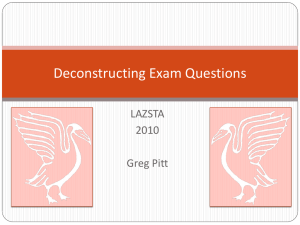Word format
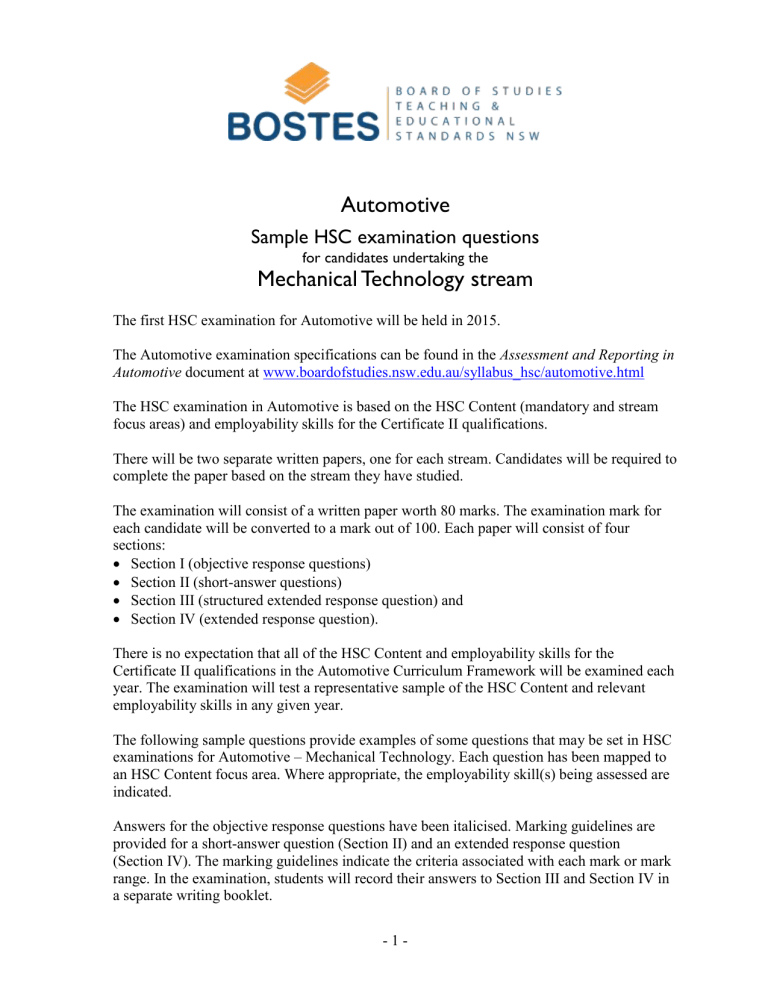
Automotive
Sample HSC examination questions
for candidates undertaking the
Mechanical Technology stream
The first HSC examination for Automotive will be held in 2015.
The
Automotive
examination specifications can be found in the Assessment and Reporting in
Automotive document at www.boardofstudies.nsw.edu.au/syllabus_hsc/automotive.html
The HSC examination in
Automotive
is based on the HSC Content (mandatory and stream focus areas) and employability skills for the Certificate II qualifications.
There will be two separate written papers, one for each stream. Candidates will be required to complete the paper based on the stream they have studied.
The examination will consist of a written paper worth 80 marks. The examination mark for each candidate will be converted to a mark out of 100. Each paper will consist of four sections:
Section I (objective response questions)
Section II (short-answer questions)
Section III (structured extended response question) and
Section IV (extended response question).
There is no expectation that all of the HSC Content and employability skills for the
Certificate II qualifications in the
Automotive
Curriculum Framework will be examined each year. The examination will test a representative sample of the HSC Content and relevant employability skills in any given year.
The following sample questions provide examples of some questions that may be set in HSC examinations for
Automotive – Mechanical Technology
. Each question has been mapped to an HSC Content focus area. Where appropriate, the employability skill(s) being assessed are indicated.
Answers for the objective response questions have been italicised. Marking guidelines are provided for a short-answer question (Section II) and an extended response question
(Section IV). The marking guidelines indicate the criteria associated with each mark or mark range. In the examination, students will record their answers to Section III and Section IV in a separate writing booklet.
- 1 -
A rubric indicating general criteria for judging performance for the extended response question in Section IV has been included with the sample question. This rubric applies only to Section IV and is used to assess responses to the extended response question together with criteria specific to the question.
The sample questions and marking guidelines provide teachers and students with guidance as to the sort of questions to expect and how they may be marked. They are not meant to be prescriptive. Each year the structure of the examination will conform with the examination specifications. However, the number and type of questions in the examination may focus on different syllabus outcomes and content, or have a different range and balance than those given in this sample set of questions.
- 2 -
Section I (15 marks)
There will be objective response questions to the value of 15 marks.
Five questions will be based on the HSC mandatory focus areas and will be the same for both papers. Ten questions will be specific to the Mechanical Technology HSC stream focus area.
Candidates are given four possible answers (A, B, C or D) from which to choose the correct
(or best) one. This type of question requires the candidate to have a degree of certainty about their knowledge and understanding of the subject.
The purpose of the other answers (distractors) is to present a range of options that appear to be feasible. Some could be correct in a given set of circumstances but are not the best overall answer. In other cases, distractors may be partially right with some element of incorrect information.
Section I sample questions
Question 1
HSC Content – focus area assessed: Safety
Battery acid has come into contact with skin.
What should be done to the affected area?
(A) Apply bicarbonate soda
(B) Pad down with a sterile rag
(C) Immediately apply an ice pack
(D) Wash thoroughly with clean water
Question 2
HSC Content – focus area assessed: Working in the automotive industry and workplace
What body has the responsibility for issuing trade licences within the automotive industry?
(A) Department of Fair Trading
(B) Motor Traders’ Association
(C) Automotive Training Board
(D) Institute of Automotive Mechanical Engineers
- 3 -
Question 3
HSC Content – focus area assessed: Mechanical Technology
Which component transmits drive from the engine to the automatic transmission on a fourwheel drive vehicle?
(A) Flywheel
(B) Pressure plate
(C) Transfer gearbox
(D) Torque converter
Question 4
HSC Content – focus area assessed: Mechanical Technology
What is the primary purpose of a fuse in an electrical circuit?
(A) To allow the current to flow into the circuit
(B) To protect the circuit against excessive current flow
(C) To ensure the current is maintained at the correct amperage
(D) To ensure continued current flow in the event of a short circuit
- 4 -
Section II (35 marks)
There will be approximately five short-answer questions.
15 marks will be based on the HSC mandatory focus areas and these questions will be the same for both papers.
20 marks will be allocated to questions specific to the Mechanical Technology HSC stream focus area.
Questions may contain parts.
There will be approximately 12 items in total.
At least two
items will be worth from 4 to 8 marks.
Section II sample questions
Question 5 (4 marks)
HSC Content – focus areas assessed: Mechanical Technology
Employability skill assessed: Problem-solving
A vehicle has dull headlights when being driven.
Outline the procedure for identifying the cause of the fault. In your answer, include equipment that you would use and name the components you would test.
………………………………………………………………………………………….
………………………………………………………………………………………….
………………………………………………………………………………………….
………………………………………………………………………………………….
………………………………………………………………………………………….
………………………………………………………………………………………….
………………………………………………………………………………………….
………………………………………………………………………………………….
………………………………………………………………………………………….
- 5 -
Marking guidelines
Question 5
Criteria
Outlines a procedure for fault-finding relevant to the scenario using a logical sequence
Identifies all equipment needed and components to be tested
Outlines a procedure for fault-finding relevant to the scenario
Identifies some equipment needed and/or components to be tested
Provides a limited response about fault-finding or lists some equipment needed or components to be tested
Marks
4
2–3
1
- 6 -
Question 6 (5 marks)
HSC Content – focus areas assessed: Safety
Working in the automotive industry and workplace
Employability skill assessed: Technology
(a) What is the correct procedure that should be followed after discovering an electric 1 tool with a frayed cord?
……………………………………………………………………………………
……………………………………………………………………………………
……………………………………………………………………………………
(b) Explain the procedure for raising a vehicle on a two-post hoist to allow a mechanic 4 to work below it safely.
……………………………………………………………………………………
……………………………………………………………………………………
……………………………………………………………………………………
……………………………………………………………………………………
……………………………………………………………………………………
……………………………………………………………………………………
……………………………………………………………………………………
……………………………………………………………………………………
……………………………………………………………………………………
……………………………………………………………………………………
- 7 -
Section III (15 marks)
There will be one structured extended response question based on the Mechanical
Technology HSC stream focus area, and can also draw from the HSC mandatory focus areas.
The question will have two or three parts, with one part worth at least 8 marks.
The question will have an expected length of response of around four pages of an examination
writing booklet (approximately 600 words) in total.
Question 7 (15 marks)
HSC Content – focus areas assessed: Mechanical Technology
Sustainability
(a) Describe the features of engine systems that contribute to improved fuel efficiency 5 and a reduction in emissions.
(b) Explain how manufacturers have used technology in modern non-hybrid petrol and 10 diesel engines to achieve fuel efficiency and reduction in harmful emissions. In your answer provide examples.
- 8 -
Section IV (15 marks)
There will be one extended response question based on the HSC mandatory focus areas and will be the same for both papers.
The question will have an expected length of response of around four pages of an examination
writing booklet (approximately 600 words).
In your answer you will be assessed on how well you:
demonstrate knowledge and understanding relevant to the question
communicate ideas and information using relevant workplace examples and industry terminology
present a logical
and cohesive response.
Question 8 (15 marks)
HSC Content – focus area assessed: Working in the automotive industry and workplace
Employability skill assessed: Communication
In the automotive workplace, communication occurs in written, verbal and non-verbal ways.
Explain the benefits of the effective use of each of these types of communication in a workshop environment.
- 9 -
Marking guidelines
Criteria
Demonstrates a depth of knowledge and understanding of the various types of communication relative to the industry
Provides a clear explanation of the relationship between effective communication and a successful workshop
Correctly uses precise industry terminology and examples within the context of the automotive industry in a well-reasoned cohesive response
Demonstrates knowledge and understanding of various types of communication relative to the industry
Provides an explanation of the relationship between effective communication and a successful workshop
Uses appropriate industry terminology with some examples relevant to the automotive industry
Demonstrates a general understanding of various types of communication
Provides a general discussion linking effective communication to a successful workshop
Uses appropriate industry terminology
Demonstrates an understanding of communication
Provides some links to the importance of effective communication
Uses basic industry terminology
Demonstrates a limited understanding of communication
Uses limited industry terminology
Marks
13–15
10–12
7–9
4–6
1–3
- 10 -


